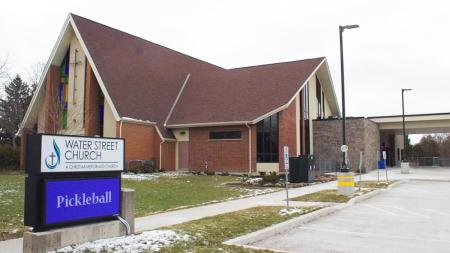CRC Office Obtains Energy Star Certification

The U.S. Environmental Protection Agency has awarded its Energy Star Certification to the Christian Reformed Church in North America’s office in Grand Rapids, Mich.
Energy Star buildings must meet strict standards that certify they use less energy, are less expensive to operate, and cause fewer greenhouse gas emissions than their peers, according the EPA.
The CRCNA office now becomes only the second denominational building in the U.S. to earn this designation. The other is the Presbyterian Church USA headquarters, said Richard Killmer, a special representative of the Office of Social Justice.
Killmer appeared on May 7 before the CRC Board of Trustees to give a plaque marking the Energy Star rating to John Bolt, the CRC’s director of finance and administration who began the process of energy-saving that led to the designation. The EPA made its award in late April.
“I think the denomination should be grateful for John’s pioneering work,” said Killmer.
“The work on this building and grounds was ground breaking, was an important witness to the community, and saved the denomination a great deal of money.”
Bolt said the CRC did not start out simply to achieve the Energy Star certification.
“In fact, it was not even on our radar. Our goal was to upgrade old building systems in such a way that would reflect the best stewardship of the resources with which we had been entrusted in terms of both the dollars the churches had given us and our impact on the environment,” he said.
Killmer said the CRC Synod in 2012 adopted a significant statement calling on the whole denomination including congregations to care for God’s creation.
It called the church to engage in efforts to combat the dangers of climate change and particularly called on congregations to reduce carbon emissions in their own buildings and to urge individuals to reduce energy use in their own homes.
Two years before the synod statement on care of creation, Bolt began to take steps in the Grand Rapids building to reduce its energy use.
“Many steps were taken to reduce the use of electricity and energy, a garden was placed on the roof and support was given to Calvin College as it worked to protect the Plaster Creek watershed, especially the portion that is on the headquarters grounds,” said Killmer.
In order for an organization to be honored by the EPA, those certified must receive a 75 on the Portfolio Manager, a benchmarking tool that evaluates how well the organization has met designated criteria, and to have the work inspected by a professional engineer.
The CRC building received a score of 94. Signs, indicating that the Energy Star certification has been given to the CRCNA, are on the doors of the building.
At the same time that the building provides an effective witness to the importance of protecting and caring for God’s creation, said Killmer, congregations are taking steps to reduce energy and greenhouse gas emissions.
There has been a pilot project at work this year to learn about the role that the denomination should take to help congregations reduce energy use.
Looking ahead, said Killmer, there may be several congregations in the pilot that also could receive Energy Star certification.
“A group of CRC churches experienced in energy stewardship met by conference call a couple of months ago to describe their good work to each other. Many impressive stories were told on that call,” he said.


